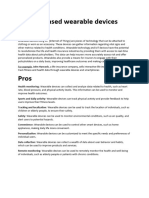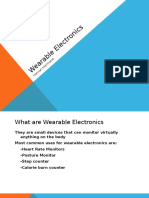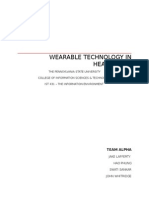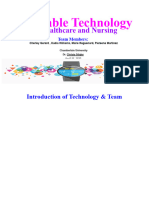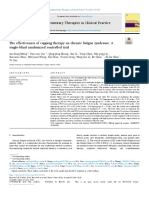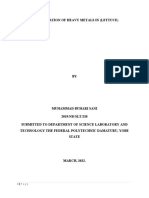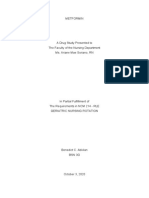Wearable Technology and Its
Health Applications
In an era where technology intertwines with daily life, “Wearable Technology and Its
Health Applications” stands as a beacon of innovation, especially for students in the US.
This comprehensive guide delves into the cutting-edge world of wearable tech, from
fitness trackers that monitor your heart rate to smartwatches that keep tabs on your
overall wellness. Here, we unravel how these devices not only track health metrics but
also offer meaningful insights into our well-being. By understanding their functionalities,
benefits, and usage tips, this guide empowers students to harness the full potential of
wearable technology, paving the way for a healthier, tech-savvy future. Whether for an
article writing competition or personal knowledge, this guide is your quintessential
resource for all things related to wearable health technology.
Wearable Technology and Its Health Applications
In the modern world, where technology and health intersect more than ever, wearable
technology has emerged as a pivotal player. This article delves into the realm of
wearable technology and its health applications, offering insights into how these
innovations are reshaping our approach to personal wellness and healthcare.
Understanding Wearable Technology
Wearable technology encompasses electronic devices that can be comfortably worn on
the body. These gadgets are designed to collect data about the user’s health and
exercise habits, offering real-time insights into various physiological metrics. From
smartwatches to fitness bands, and even advanced clothing embedded with sensors,
wearable technology is revolutionizing how we interact with health data.
Copyright @ EXAMPLES.COM
�Health Applications of Wearable Technology
1. Fitness Tracking:
○ Overview: The most common application is fitness tracking, where
devices monitor physical activity, steps taken, calories burned, and
workout intensity.
○ Impact: This data helps users set and achieve fitness goals, fostering a
more active lifestyle.
2. Heart Rate Monitoring:
○ Overview: Many wearables come equipped with heart rate sensors,
providing continuous heart rate data.
○ Impact: This is crucial for detecting heart-related health issues early and
maintaining cardiovascular health.
3. Sleep Monitoring:
○ Overview: Wearables can track sleep patterns, including the duration and
quality of sleep.
○ Impact: This data is vital for understanding and improving sleep habits,
which is essential for overall health.
4. Stress Management:
○ Overview: Some devices offer stress level monitoring through various
metrics like heart rate variability.
○ Impact: This helps in managing stress more effectively, promoting mental
wellbeing.
Advancements in Wearable Health Technology
The field of wearable health technology has seen remarkable advancements in recent
years, significantly enhancing how individuals monitor and manage their health. Below
are key steps highlighting these advancements:
● Smart Fabrics and Interactive Textiles:
● Enhanced Biometric Monitoring
● Incorporation of AI and Machine Learning
● Longer Battery Life and Improved Energy Efficiency
Copyright @ EXAMPLES.COM
� ● Integration with Telehealth and Remote Monitoring
● Enhanced User Interface and Customization
● Expansion in Health Ecosystem Connectivity
● Development of Non-Invasive Monitoring Techniques
● Inclusion of Mental Health Monitoring
● Custom Health Reports and Analysis
Choosing the Right Wearable Technology
When selecting a wearable device, consider the following:
● Accuracy: Look for devices known for their precision and reliability.
● Comfort and Style: Choose a device that suits your comfort level and personal
style.
● Battery Life: Opt for devices with longer battery life for uninterrupted health
tracking.
● Compatibility: Ensure the device is compatible with your smartphone or other
digital devices.
Tips for Maximizing Benefits from Wearable Technology
● Consistent Usage: Wear the device consistently to collect comprehensive health
data.
● Set Personal Goals: Use the data to set and track personalized health goals.
● Integrate with Lifestyle: Make the wearable a part of your daily routine for
holistic health monitoring.
● Stay Informed: Keep abreast of the latest updates and features of your device to
maximize its potential.
What are the applications of wearable devices in healthcare?
Copyright @ EXAMPLES.COM
�Wearable devices in healthcare track vital signs, monitor chronic conditions, support
rehabilitation, aid in early disease detection, and offer remote patient monitoring
capabilities.
What are 3 health benefits of wearable technology for
patients with health conditions?
Wearable technology offers real-time health data, improves disease management, and
enhances patient engagement and compliance in treatment plans for chronic condition
management.
How wearable technology is used in health and safety?
Wearable technology in health and safety includes monitoring work-related risks,
alerting to hazardous conditions, and ensuring compliance with health and safety
protocols.
Wearable technology and its health applications are transforming the landscape of
personal health and fitness. By providing valuable data and insights, these devices
empower individuals to take charge of their health. As technology continues to evolve,
the potential for wearable technology in healthcare is boundless, offering a promising
future for personalized health monitoring and management.
Copyright @ EXAMPLES.COM














